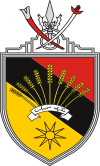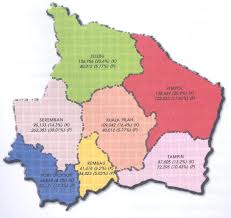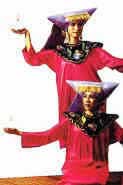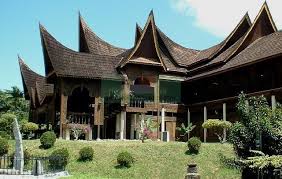


HISTORY
The Minangkabaus from Sumatra settled in Negeri Sembilan in the 14th century under the protection of the MalaccaSultanate, and later under the protection of its successor, the Sultanate of Johor. Negeri Sembilan is the only state in Malaysia which practices matrilineal custom brought by Minangkabau. As Johor weakened in the 18th century, attacks by the Bugis forced
the Minangkabaus to seek protection from their homeland. The
Minangkabau ruler, Sultan Abdul Jalil, obliged by sending his near
relative, Raja Melewar. When he arrived, he found that another royal,Raja Khatib had
already established himself as ruler. He declared war against Raja
Khatib and became the ruler of Negeri Sembilan. The Sultan of Johor
confirmed his position by granting the title Yang di-Pertuan Besar Negeri
Sembilan (He Who is Highest Lord of the Nine States) in 1773. After
Raja Melewar's death, a series of disputes arose over the succession.
For a considerable period, the local nobles applied to the Minangkabau
ruler in Sumatra for a ruler. However, competing interests supported
different candidates, often resulting in instability and civil war.
In 1873, the British intervened militarily in a civil war in Sungai Ujong to preserve British economic interests, and placed the country under the control of a British Resident. Jelebu followed in 1886, and the remaining states in 1895. In 1897, when the Federated Malay States (FMS) was established, Sungai Ujong and Jelebu were reunited to the confederation of small states and the whole, under the old name of the Negeri Sembilan, was placed under a single Resident and became a member of the FMS.
The number of states within Negeri Sembilan has fluctuated over the years, the federation now consists of six states and a number of sub-states under their suzerainty. The former state of Naning was annexed to Malacca, Kelang to Selangor, and Segamat to Johor.
Negeri Sembilan endured Japanese occupation in World War II between 1941 and 1945, and joined the Federation of Malaya in 1948, and became a state of Malaysia in 1963.
It originally consisted of 9 districts:
- Jelai (Inas)
- Jelebu
- Johol
- Kelang (now a district in Selangor)
- Naning (now a district in Malacca)
- Rembau
- Segamat (now in Johor) / Pasir Besar (now in Tampin)
- Sungai Ujong
- Alu Panah (now divided between Jelebu and Pahang State)
The state comprises 7 districts (NOW):
Ostritch Farm
The PD Ostrich Farm is located at 9th mile along the Port Dickson beach road; watch out for a signboard at left while going south from town. Besides ostriches, visitors can see peacocks, peasants, jungle fowls, monkeys and a strangely large number of farm animals. The ostriches are housed in open paddocks shaded by large trees; they can be feed with pellets bought from the entrance. For a fee, adults and children can even ride ostriches around a small circuit at the back for the farm. A restaurant on the premises serves cuisine made from ostrich meat, including satay. Open daily from morning till evening, tickets are priced at MYR8 per adult and MYR4 per child.
Ulu Bendul Recreational Forest The Ulu Bendul Recreational Forest located 16km from Seremban is a haven for nature lovers. Lying at the foot of Bukit Angsi, the park is a favourite spot for picnickers on weekends because of its cool shady surrounding and mountain streams that meander through the park. For the adventurous, try climbing Bukit Angsi and enjoy a scenic view of Seremban and the beautifu surroundings.

Ulu Bendul Recreational Forest
Pedas Hot Springs The Pedas Hot Springs is located in the district of Rembau, 30km south of Seremban. The sulphurous content of its pools is claimed to have curative properties for skin conditions and other ailments.

Traditional Negeri Sembilan food is hot and spicy, as one of the ingredients used is the chili padi, the hottest of chillies. Popular dishes include rendang, (pieces of beef cooked in coconut milk and chillies). One should experience the unique Minangkabau style of cooking, which sees generous portions of 'chili padi' (small & extremely hot chilies) being used.

Another NS specialty is "Lemang", glutinous rice cooked in coconut milk in a bamboo stem over an open fire. This is normally served with Rendang, a deliciously thick, dry meat curry.
Dances
Negeri Sembilan also boasts traditional music like the Caklempong, Dikir Rebana, Tumbuk Kalang, and Bongai.
Even the musical instruments used bear some semblance to Sumatra, the ancestral home of the Minankabau people. Dances like the tarian lilin (candle dance) and rentak kuda (beat of the horse) are popular. Not to mention the beautifully coordinated graceful movements of the dancers in their colorful costumes in the captivating Tarian Piring and the upbeat tempo of Tarian Randai. Unlike modern dance, each beat, rhythm and movement in these dances combine to form a story, maybe of a bygone myth or simply a reflection of the lifestyles of another era.
They are usually performed at traditional festivities, cultural events and dinner-cum-cultural shows. The movements of the dance with the music pulsating, create a joyous air of fiesta and revelry among the celebrants and are often rhythmically alluring..

Teratak Perpatih
Nearby, stands the Teratak Perpatih house, commanding a prominent presence in the complex. Its unique roof design, mimicking the two pointed ends of a buffalo's horns is typical of Minangkabau traditional house. Inside, you can find local crafts including porcelain, woodcraft and batik. Other exhibits available here include traditional musical instrument and Minangkabau costume.
